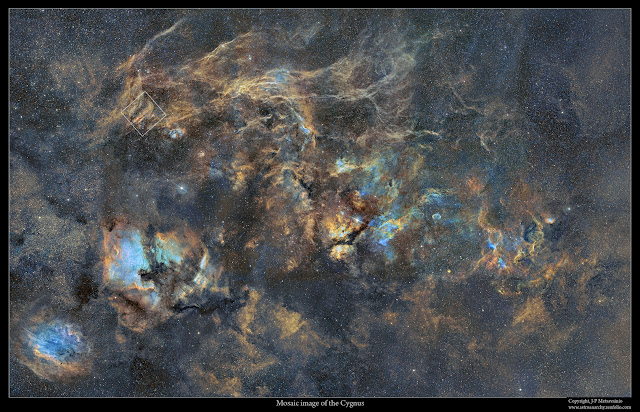COPYRIGHT, PLEASE NOTE
All the material on this website is copyrighted to J-P Metsavainio, if not otherwise stated. Any content on this website may not be reproduced without the author’s permission.
Have a visit in my portfolio
PORTFOLIO:https://astroanarchy.zenfolio.com/
Monday, November 9, 2015
Filaments of Cygnus
There are lots of dim gas filaments at west side of the Cygnus nebula complex. I have spent this Autumn season by shooting them. Due to close proximity of brighter and more eye catching nebulae in Cygnus, this area is not very commonly imaged.
Filaments of Cygnus
Click for a large imageNatural color composition from the emission of ionized elements.
Filaments of Cygnus in HST-mapped colors
Click for a large image
Image in mapped colors from the light emitted by ionized elements.
Red=Sulfur, Green=Hydrogen and Blue=Oxygen.
An experimental starless version
Click for a large imageAn experimental starless version
The actual nebula is easier to observe in this starless photo
A closeup
Interesting shapes in the nebula, they must be some kind of shock fronts
Orientation in the constellation Cygnus
Click for a large image
The area of interest is marked as a white rectangle in this 18-panels narrow band mosaic of the Cygnus.
Technical details
Processing work flow
Image acquisition, MaxiDL v5.07.
Stacked and calibrated in CCDStack2.
Deconvolution with a CCDStack2 Positive Constraint, 21 iterations, added at 25% weight
Color combine in PS CS3
Levels and curves in PS CS3.
Imaging optics
Celestron Edge HD 1100 @ f7 with 0,7 focal reducer for Edge HD 1100 telescope
Mount
10-micron 1000
Cameras and filters
Imaging camera Apogee Alta U16 and Apogee seven slot filter wheel
Guider camera, Lodestar x2 and SXV-AOL
Astrodon filter, 5nm H-alpha
Astrodon filter, 3nm O-III
Astrodon filter, 3nm S-II
Exposure times
H-alpha, 15 x 1200s = 5h.
O-III, 6 x 1200s binned = 2h
S-II, 6 x 1200s binned = 2h
Total 9h
Labels:
Narrowband color images,
nebula
Subscribe to:
Post Comments (Atom)















No comments:
Post a Comment